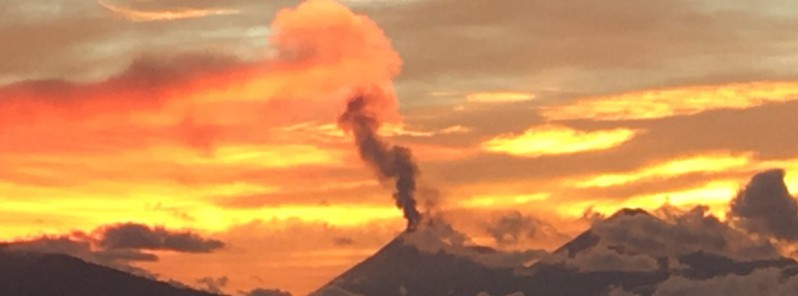New eruptive phase starts at Fuego volcano, ashfall reported

A change in the pattern of activity at Fugo volcano, Guatemala has been observed on December 10, 2017, developing into the 12th effusive eruption phase of the year.
The Fuego Observatory reports moderately strong explosions which generate ash columns to a height of 5 000 m (16 400 feet) above sea level, drifting more than 15 km (9 miles) to the SW, S and SE.
The incandescent material is reaching a height of 500 m (1 640 feet) above the crater, feeding three lava flows that traveled 1 500 m (5 000 feet) down the Seca (Santa Teresa) ravine, 800 m (2 600 feet) down the Ceniza, and 300 m (984 feet) down the Taniluyá.
The explosions are accompanied by moderate rumblings which emit waves of moderate and strong shocks, causing roofs of nearby houses to vibrate.
Ashfall was reported in areas surrounding La Rochela, San Andrés Osuna, Morelia, Panimache I and II. There is also a possibility of ash fall in Escuintla, INSIVUMEH said.
Authorities warn there is a possibility of pyroclastic flows, urging residents and the public not to approach the ravines.
The Washington VAAC said an intense hot spot is visible at the crater in satellite imagery despite meteorological cloud. However, volcanic ash is not seen due to dense clouds in the vicinity.
The 11th effusive eruption phase in 2017 began on November 5 and ended on November 7. Ashfall was reported in areas downwind including Panimaché I and II (8 km SW / 5 miles), Santa Sofía (12 km SW / 7.5 miles), Morelia (9 km SW / 5.6 miles), and El Porvenir.
#Volcan #Volcano #Fuego #Guatemala https://t.co/M6gXpwrWUj Photo Nico BABOT pic.twitter.com/4wLLDpuEuF
— Shérine (@SherineFrance) December 11, 2017
Pinceladas en el cielo en el atardecer #chapin de ayer domingo. #volcan de fuego en plena erupción para hacerlo más espectacular. Sin duda una belleza. Foto sin #filtro pic.twitter.com/hR5zWTotnY
— Alejandro Vargas (@alejandrov70) December 11, 2017
Fuego. #volcan #fuego #volcanactivo #prensalibre #guatevision_tv @guatevision_tv @prensa_libre https://t.co/9oH4lGzEaE pic.twitter.com/uwYSRRWT5i
— S. Letona (@neusminnaar) December 11, 2017
Geological summary
Volcán Fuego, one of Central America's most active volcanoes, is one of three large stratovolcanoes overlooking Guatemala's former capital, Antigua. The scarp of an older edifice, Meseta, lies between 3 763 m (12 345.8 feet) high Fuego and its twin volcano to the north, Acatenango. Construction of Meseta dates back to about 230 000 years and continued until the late Pleistocene or early Holocene. The collapse of Meseta may have produced the massive Escuintla debris-avalanche deposit, which extends about 50 km (31 miles) onto the Pacific coastal plain.
The growth of the modern Fuego volcano followed, continuing the southward migration of volcanism that began at Acatenango. In contrast to the mostly andesitic Acatenango, eruptions at Fuego have become more mafic with time, and most historical activity has produced basaltic rocks. Frequent vigorous historical eruptions have been recorded since the onset of the Spanish era in 1524, and have produced major ashfalls, along with occasional pyroclastic flows and lava flows. (GVP)
Featured image: Fuego volcano erupting on December 11, 2017. Image copyright Alejandro Vargas

Commenting rules and guidelines
We value the thoughts and opinions of our readers and welcome healthy discussions on our website. In order to maintain a respectful and positive community, we ask that all commenters follow these rules:
We reserve the right to remove any comments that violate these rules. By commenting on our website, you agree to abide by these guidelines. Thank you for helping to create a positive and welcoming environment for all.